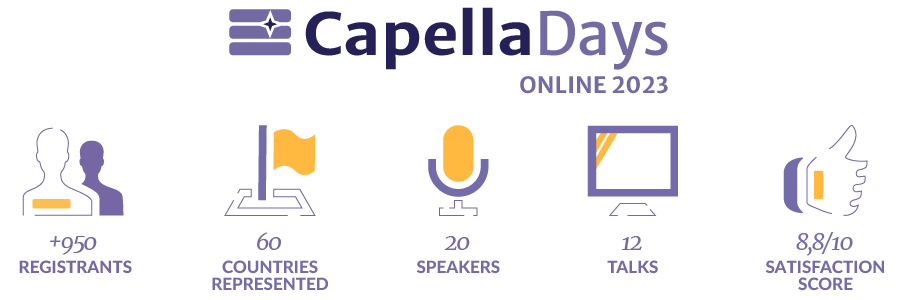

Capella Days regularly brings together the community of Capella and Arcadia:
Capella Days is your opportunity to learn from Capella ecosystem members! Benefit from the experience of industrial adopters who have sucessfully deployed an MBSE approach with Arcadia and Capella on their projects.
See all the editions.
| Time | Talks | Speakers |
|---|---|---|
| 3:30 pm UTC+1 | Welcome and Introduction | |
| 3:35 pm UTC+1 | Collaborative Model-Based Engineering and Large Systems Development | Catherine Morlet (European Space Agency) Alberto González Fernández (European Space Agency) |
| 4:25 pm UTC+1 | Introducing MBSE in an Organization Successfully | Erik Visser (Thales Communications) |
| 5:15 pm UTC+1 | Model-driven Design and Development of an Electromechanical Actuation System | Elena García Llorente (CESA - Heroux Devtek) Luis Cárdenas González (Anzen Engineering) |
| 6:05 pm UTC+1 | Closing |
3:30 pm UTC+1 = 3:30 pm CET (Paris) = 11:30 am UTC-3 (Brasilia) = 9:30 am EST (New York) = 6:30 am PST (Los Angeles)
| Time | Talks | Speakers |
|---|---|---|
| 9:30 am UTC+1 | Welcome and Introduction | |
| 9:35 am UTC+1 | Practice in COMAC to Conduct MBSA in Avionics System Based on Capella | Wang Ran (COMAC) Yan Weizhen (PGM) |
| 10:25 am UTC+1 | Capella for Modelling CubeSat: Tailored SE Process for Leveraging Model-Based Systems Engineering | Suvigya Gupta (BlueKei Solutions) Dhirendra Singh (BlueKei Solutions) Stueti Gupta (BlueKei Solutions) |
| 11:15 am UTC+1 | Enterprise Modelling for Lifecycle Engineering on the Example of Sustainability | Chantal Sinnwell (Siemens Digital Industries Software) Michael Bitzer (Siemens Digital Industries Software) |
| 12:05 pm UTC+1 | Closing |
9:30 am UTC+1 = 2:00 pm IST (Pune) = 4:30 pm CST (Beijing) = 5:30 pm JST (Tokyo) = 7:30 pm AEST (Sydney)
| Time | Talks | Speakers |
|---|---|---|
| 3:30 pm UTC+1 | Welcome and Introduction | |
| 3:35 pm UTC+1 | Capella MBSE Integration for Robotic Arm Development | Vinayak Vadlamani (Redwire Space Europe) |
| 4:25 pm UTC+1 | Enhance the Efficiency of Systems Engineering with a Tailoring of SE Processes and ARCADIA Method | Bruno Vuillemin (Capgemini Engineering) |
| 5:15 pm UTC+1 | In Pursuit of Robust Failure Mode Effects Analysis in the Design Phase | Steven Huang (ManTech) Alice Cellamare (p2m berlin) |
| 6:05 pm UTC+1 | Closing |
3:30 pm UTC+1 = 3:30 pm CET (Paris) = 11:30 am UTC-3 (Brasilia) = 9:30 am EST (New York) = 6:30 am PST (Los Angeles)
| Time | Talks | Speakers |
|---|---|---|
| 3:30 pm UTC+1 | Welcome and Introduction | |
| 3:35 pm UTC+1 | Use of Capella as Digital Twin to Perform Complex Systems Simulation | Christopher Cerqueira (Instituto Tecnológico de Aeronáutica) |
| 4:25 pm UTC+1 | Efficient and Comprehensive FMECAs: Harnessing the Power of MBSE Models in Capella | Sushim Koshti (Applied Materials) Neela Ayalasomayajula (Applied Materials) |
| 5:15 pm UTC+1 | Lean Startup with Capella MBSE | Brent Bailey (StarFish Medical) |
| 6:05 pm UTC+1 | Closing |
3:30 pm UTC+1 = 3:30 pm CET (Paris) = 11:30 am UTC-3 (Brasilia) = 9:30 am EST (New York) = 6:30 am PST (Los Angeles)
TUESDAY 14th of NOVEMBER | 3:35 pm UTC+1
This presentation reports on the collaborative Model-Based System Engineering (MBSE) approach followed for Galileo Second Generation using Team for Capella. We address the choices made and methodology applied in Phase B of the system design activity in the past years, with a team spread in different companies’ and geographically distributed. We address the handling of branches of model at different security classification levels with an approach based on synchronising branches rather than split of a large model that makes it suitable for parallel development thus compatible with schedule/time-keeping constraint of the project. Overall, there is a need of rigorous methodology to facilitate synchronisation activities, to have common development approaches including terminology/nomenclature to identify relevant classified items (functions, exchange item, scenarios, etc.), and to document/textualized the information allowing for automatic and frequent generation of the design documentation.
In large projects, team members are involved in different roles, thus implying “rules” as well on who is acting on a part of a model. But also, some may be focused on review/supervision of the model which implies the need for means for commenting models rather than developing. Instead of exporting (e.g. in word documents) we expect that tools such as “Publication for Capella” would help enlarging the users of MBSE within the team.
Another area under investigation is the collaboration across teams to ensure digital continuity throughout the disciplines or sub-systems. We are starting to use the system-to-subsystem transition plugin with the aim to maintain interfaces between sub-systems and specification of each subsystem, and apportion some engineering parameters between subsystems thanks to a model. Direct interaction at model level is expected, and, through synchronisation mechanisms, integrate at the system level the outcomes from the subsystems in a form of a federated model.
TUESDAY 14th of NOVEMBER | 4:25 pm UTC+1
Do you strongly believe in Model Based System Engineering? Do you think MBSE leads to building better products? Do you really love Capella? So did we!
Nevertheless, when we attempted to introduce model based system engineering in our organization a couple of years ago, we failed to make that a success.
Apparently, introducing MBSE, Arcadia and Capella in an organization requires more than just the manual for Capella and reading Jean-Luc Voirin's great book on Arcadia.
This presentation will share the experiences and the lessons we learned, that allowed us to (re)introduce MBSE in our organization successfully.
TUESDAY 14th of NOVEMBER | 5:15 pm UTC+1
Coordination of multidisciplinary teams is often a challenge when facing the design and development of complex systems subjected to strict product policies such as the standards applicable in the aeronautics industry.
Model-based systems engineering, and more generally, model-driven approaches to design and develop such systems offer alternatives to facilitate the work of the main stakeholders involved in the process. In particular, the paradigms of centralized source of information, enhanced traceability or automated analysis speed-up significantly the design and verification tasks and reduce the sources of errors; which results in an overall gain of quality in the engineering processes.
In this talk we will showcase the implementation of a model-driven approach to the design and development of an electromechanical actuator conceived to control the aerodynamic surfaces of a conventional aircraft. Our industrial partner is involved in a transformation process towards the digitalization of their engineering activities and is interested in particular in using MBSE as a way to foster collaboration between teams and ensure consistency across different engineering tasks.
Our work started with an analysis of different MBSE tools, evaluating the suitability of such tools to meet a set of criteria considered relevant to support efficiently the process, not only at systems engineering level, but also coupling with other engineering disciplines that will interact with the model. For different reasons that will be detailed in the webinar Capella was selected as the reference platform for this activity.
Using Capella, the stakeholder needs for the electromechanical actuator have been analyzed and developed across the system, logical and physical architectures. In the talk, the main features of the system will be described, emphasizing the specificities of the model that allow the coordination and sharing of information between teams (mainly electronics, simulation and RAMS).
WEDNESDAY 15th of NOVEMBER | 9:35 am UTC+1
COMAC is one of the world's leading civil aircraft suppliers, and its avionics system architecture design is completed based on Capella.
We will introduce how we extend Capella in COMAC to support 4761-compliant MBSA work. It includes how to define failure conditions in Capella PA model, how to carry out failure propagation modeling on Capella function, behavioral physical component, and node physical component, how to automatically generate fault trees for failure conditions, and how to carry out safety analysis based on the calculation results of the minimum cut set of each fault tree, and so on.
 |
Wang Ran (COMAC)Wang Ran, COMAC safety engineer mainly conducts safety analysis of complex architecture like IMA system and is committed to researching model-based safety analysis. |
 |
Yan Weizhen (PGM)Yan Weizhen is a system engineering consultant from PGM, and has gradually built MBSE and MBSA solutions for avionics systems with the COMAC EE team. |
WEDNESDAY 15th of NOVEMBER | 10:25 am UTC+1
CubeSat developers face a unique set of challenges when designing and deploying small satellite systems. They are continually striving to enhance reliability and efficiency of these small satellite systems. Evolving mission requirements arise a need to provide for objective evidence of mission assurance. Systems Engineering approach backed up by MBSE practices can enable minimizing project disruptions by optimizing and ensure that CubeSats can adapt to evolving mission requirements. This could facilitate efficient resource allocation, minimize design errors, and enhance overall mission success. CubeSat developers can optimize operational and system analysis, construct a comprehensive End Product Breakdown Structure, tailor SE efforts to the development lifecycle, and effectively tackle common development challenges, such as compatibility issues during integration and testing.
The goal of this presentation is to enable CubeSat developers seamlessly integrate SE practices along with MBSE into their existing workflows.
Keeping our assumptions close to industry practice, a model has been developed relying on available literature on CubeSat development using Capella. Using the model as reference, this presentation will be highlighting on proposed tailored SE process that is intended to provide a strategic advantage by enabling more predictable project outcomes. The model will be focused on supporting systematic decomposition of CubeSat functions and architectures to gain a clearer understanding of system's operational logic and physical components. It would also address effective interface management and agile development using functional chain that could further contribute to increased redundancy for CubeSat.
In conclusion, by embracing SE & MBSE practices, it is intended to promote the development of CubeSats that remain reliable throughout their operational lifetimes, furthering advancements in space exploration, scientific research, and technology demonstration.
WEDNESDAY 15th of NOVEMBER | 11:15 am UTC+1
Systems Engineering is a methodology to design complex systems in interdisciplinary teams from concept to production to operation. It considers the complete problem with its business and technical needs: operations, cost and schedule, performance, training, support, test, manufacturing, and many more. Companies that strive to become Digital Enterprises can leverage Systems Engineering as an approach to consider a company as a System-of-Systems with its individual lifecycles and ecosystems along their Digital Transformation.
When applying model-based Systems Engineering (MBSE) to model required Digital Enterprise capabilities, this approach also supports companies in understanding the impact of topics like e.g. Sustainability. Sustainability impacts a company’s product portfolio, manufacturing systems, service delivery as well as most other business processes. Though, sustainability-oriented approaches like Lifecycle Engineering are necessary, to consider the comprehensive technical, environmental, and economic impacts of decisions within the Enterprise System Lifecycle.
This talk will explain – based on a comprehensive example on digital farming solutions – how System Engineering can be applied to understand causalities in Enterprise Systems and to come to meaningful strategic business decisions. It will illustrate how Capella Models can be used for MBSE of agricultural Enterprise Systems with their Products (e.g. grain, meat, milk), Manufacturing Systems (fields, agricultural machinery, stables), Business Processes (e.g. sowing, fertilizing, harvesting, milking) and Ecosystems (e.g. agricultural machinery manufacturers, contract workers, satellite data providers). This talk will also demonstrate, how such Capella Models can consequentially be leveraged to apply the method of Lifecycle Engineering to understand the impact of lifecycle-spanning topics like Sustainability on the Architecture of Enterprises, its Products, Manufacturing systems and Business Processes.
WEDNESDAY 15th of NOVEMBER | 3:35 pm UTC+1
The Staark robotic arm is a robotics subsystem solution for orbital servicing platforms comprising a 6 DoF manipulator, a robotic control unit, a universal tool flange with power, mechanical and data interfaces. Together with relevant end effector tools, it can accomplish a variety of on-orbit tasks such as close inspection & tracking, capturing/grasping/berthing operations, manipulation and relocation, payload manipulation, installation of attachable payloads, in space assembly and disassembly tasks, refueling assistance tasks, deployment of large satellites, and multiple tool exchange for servicing applications.
An intensive verification and validation campaign is often required for space robotics missions, this involves early validation tools in order to achieve mission assurance early on such as Phase 0 and Phase A feasibility studies. A lot of early customer development for Staark involves work on defining functional requirements to precise specifications. Once flowed down, system engineers translate mission tools to robotic architecture, defining system elements, and capturing operational interfaces. A fully defined robotic task specification is not easily definable through ROS, or other standard space operating systems. Many requirements seldom get flown down and are discovered at a later stage when challenges are faced in operating robotics in such extreme environments. To solve this gap, we introduce MBSE as a enveloping canvas for requirements filtering and microscoping.
Systems engineers spend much time in specifying a "perfect" text requirement than to derive a system level relationship. Model based systems engineering is pivotal in defining and developing scenarios that are required to comply with safety and space situational norms. Such is the need for tight coupling for robotics missions between system behaviour and physical implementation. In order to build such robustness into each mission, Redwire Space Europe trialled the Capella Model-Based Systems Engineering tool to capture higher level robotic needs, and task details and their relationship to lower level physical and functional models. Using Capella, we focused on formalizing Concept of Operations (ConOps) development for a robotics architecture that has a general physical architecture. A slightly different approach was required in order to capture interfaces needed for frozen and anticipated interfaces (operational and software) to enable special operational scenarios. Capella was basically used as a system-level "needs-ops-requirements" analysis playground that strives away from traditional requirements formulation due to complex inter-system analysis and dependencies.
WEDNESDAY 15th of NOVEMBER | 4:25 pm UTC+1
The latest INCOSE Handbook V5 defines the Tailoring to “adapt the processes to ensure that they meet the needs of an organisation or a project.
The objective of this paper and presentation is to share a tailoring approach defined by CAPGEMINI Engineering for System Engineering processes and ARCADIA method. This approach is generic and is used into several projects for Energy and Railway industries.
The objective of this approach is to enhance the efficiency (value driven) of the System Architecting and Engineering activities on a project.
The principle of the tailoring approach is to focus from “generic” (coming from SE standards or general-purpose ARCADIA description or general-purpose usage of CAPELLA tool) down to a “specific” (applicable by the project team for the objectives and the context of a real project).
This approach is based on a framework (to define generic standards, processes and method). Then, several steps of the approach allow to tailor generic processes and the ARCADIA method. Then, the tailored SE processes and the tailored ARCADIA method are formalized into documents to allow their concrete application on a real project by the project team.
The tailoring framework defined by CAPGEMINI is composed of 1) a BPMN model of SE processes, activities and tasks from ISO15288 / INCOSE Handbook, 2) a generic datamodel of SE concepts used by processes, 3) an ARCADIA cartography of levels, objects and views.
The steps of the approach allow to define SE/MBSE added values expected by the project. Then a ranking of complexity of the System of Interest will support the tailoring of SE processes and ARCADIA method.
To support the concrete application of the project, the output of the tailoring approach is a SEMP document (System Engineering Management Plan) for the project and a MBSE method based on ARCADIA. Trainings sessions on the MSBE tailored method and on the CAPELLA tool allow a right deployment on the project.
MBSE models are means and not objectives.
WEDNESDAY 15th of NOVEMBER | 5:15 pm UTC+1
In the field of Systems Engineering, the anticipation of failures is of paramount importance, especially in the advanced stages of system design. In practice failure mode effects analysis (FMEA) is performed using a bottoms-up approach to be as thorough as possible at identifying and understanding system failure modes and their causes. Failure modes are typically prioritized according to how serious their consequences are, how frequently they occur, and how easily they can be detected.
The objective of this work, which was carried out in the context of the INCOSE Mentoring Program, is to develop a methodology that harnesses all the information embedded within the system model, minimizing reliance on human conjectures. By utilizing the Python4Capella AddOn, a prototype script has been developed for Capella, aiming to automate parts of the analysis process and defining a set of potential failure modes which is as comprehensive as possible.
Central to this exploration is the use of the concepts of Configuration and Situation, as implemented in the VPMS viewpoint AddOn. These notions offer potential for a more detailed understanding of failure effects, aiding safety analysts in priority scoring.
This presentation will describe how we relate three different failure classes to failure effects by relying particularly on the information in Exchange Scenario diagrams and illustrate an example of implementing such an method using a common system model in Capella.
The main goal of this talk is to collect feedback from the event participants on the need for such a method, on potential problems in the implementation and on the way this analysis is otherwise carried out.
THURSDAY 16th of NOVEMBER | 3:35 pm UTC+1
In the presentation will be discussed the problem of safe integration of unmanned aircrafts into non-segregated airspace.
It will be presented how we are setting up open-source approaches to interconnect tools, perform state-driven simulations, and use Capella as a simulation node into distributed simulation.
 |
Prof. Dr. Christopher Cerqueira (Instituto Tecnológico de Aeronáutica) |
Video (coming soon) Slides
THURSDAY 16th of NOVEMBER | 4:25 pm UTC+1
Model-Based Systems Engineering (MBSE) has redefined the paradigms of systems engineering, and Capella stands out as a quintessential MBSE tool. One of the emergent challenges in this space is the seamless translation of information from MBSE models into other actionable formats, such as FMECAs (Failure Modes, Effects, and Criticality Analysis). Historically, the FMECA generation process has been reliant on cross-functional engineering teams collaborating in brainstorming sessions to identify potential failure modes before they can even start analysis the effects and criticality of these failure modes. While effective, this approach is time-consuming and can often overlook critical failure modes due to the inherent limitations of manual brainstorming.
Using a case study from the semiconductor equipment industry, our presentation describes a method of leveraging Capella MBSE models to streamline the generation of FMECAs. Utilizing Python4Capella, we automated the extraction of vital MBSE model objects and relationships, essential for generating an exhaustive FMECA, and seamlessly populated it into an MS Excel based FMECA template that is commonly used by the engineering community.
This presentation will offer participants:
Equipped with a practical exploration of our methodology, attendees will be equipped with a potent strategy, not only to reimagine FMECA generation in their domains but also to maximize the potential of their MBSE models, making design reliability and safety assessments more rigorous and efficient.
 |
Sushim Koshti (Applied Materials)Systems Engineer. |
 |
Neela Ayalasomayajula (Applied Materials)Systems Engineer, CAE & Process Engineering. |
THURSDAY 16th of NOVEMBER | 5:15 pm UTC+1
In the last 15 years, entrepreneurs have developed methodologies to guide them in creating products and services that customers want. This presentation focuses on applying some of these Lean Startup techniques within Capella to effectively arrive at system architectures.
In contrast to other MBSE programs, Capella embeds a design methodology that drives its usage; it provides a framework for defining the problem before progressing to solutions. This presentation will guide the strategic application of Lean Startup techniques within the different architectural levels prescribed by ARCADIA.
To ensure problem-solution fit for each stakeholder, unique Value Proposition Canvases (VPCs) connect their needs and wants with how the system will work for them. In the Operational Analysis phase, problem interviews will help determine the Customer Profile portion of the VPCs. Functions in the System Analysis represent the gain achievers and pain relievers proposed in the VPCs Value Map section. These are then validated with solution interviews before starting the logical or physical architecture.
During both stages of the architectural design, functional chains are used to determine which parts of the design need to be validated. Minimum Viable Products (MVPs), based on these functional chains, can be built to collect validated learnings about customers and other stakeholders. MVPs are not saleable products themselves, but the learnings from these MVPs are integrated in the architecture to ensure that the final product creates value.